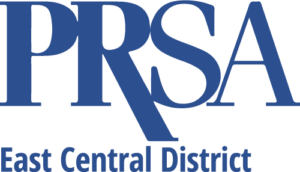‘COVID CLASS’ AT HOOSIER CHAPTER FINDS OPPORTUNITY IN VIRTUAL APR TRAINING

ECD June Meeting Best Practice Presentation “Creating a Virtual APR Class” by Leslie Galbreath, APR, & Accreditation Chair for the Hoosier Chapter
Leslie Galbreath began her Best Practice presentation “Creating a Virtual APR Class” at the June 24 ECD board meeting by saying taking APR virtual is “a big topic” and the Hoosier program had a really good head start, because the Hoosier chapter is one of most active in country in APR.
“In my own experience, years ago when I was thinking about becoming an APR, much of my business was global and I had a lot of travel overseas,” said Leslie “Life would happen, and I would have to get out of the APR training group. Taking the class centered me on being a student again, but it was not always accessible.
“I developed a couple of objectives beyond just running an APR program: First, recruit more candidates. Second, and more importantly, modernize and improve the learning experience for the modern professional. Times are changing with more people getting degrees online.”
Hoosier Chapter’s First Steps to Virtual
Leslie said, “One semester online, one semester in person was the plan. We wanted to give working folks with other obligations more flexibility. We wanted to improve the experience and work with National to improve the curriculum.
“We achieve that by doing a few things: We tried alternating online/in-person instruction for the first time last year. To be honest, some of the more experienced instructors had trouble getting used to online instruction, while the younger pros were more used to it.”
Leslie said “We got lucky” in terms of timing. “With COVID-19, people had more time on their hands. We had 50 percent more attendance in online classes. It definitely broadened our reach up and down the state.”
Going Forward with Virtual
“We’re going to do fall semester online, with the way the coronavirus is going,” said Leslie. “Until last spring if you were an APR you could teach one of the courses. Our survey feedback said there were really great instructors and some very green. We talked with the national board and instituted a three-year (APR) requirement and that upped the quality of the instructors. We placed an emphasis on personal experience. In the end, especially (preparing for) the exam, they answered questions in the curriculum and applied real-world experience.
Versatility with Virtual
“We always make it a practice to record sessions with the Facebook group. They always have the ability to go back and review. It was required for first-time instructors to have engagement inside the Facebook group. They’re checking in, having conversations, and it’s kind of fun.
“We required each instructor to come to the lessons with five questions about the curriculum and give students a chance to talk. The sessions started out at two hours, but we moved them to 90 minutes.
That seemed to be the threshold of attention span. We spent time going through student projects. We included the satisfaction survey and benefitted from student comments.
“In the second year of taking the program virtual; we’ve seen a 50 percent increase. Two from our ‘COVID class” we call it, have applied for National. We’re getting better learning retention and better satisfaction in general. We’re looking at it long term. It’s certainly a good option right now.”
Q&A
Jennifer Flowers-Kolf: Did you charge for the online class?
Leslie: No, it was free for active members.
Jennifer: Would cost be a barrier to participation?
Leslie: We debated that in board meetings. These are questions for long-time changes, if we can continue with success of program, but we’re not there yet.
Mark Pompilio: What virtual platforms did you use?
Leslie: The sessions were Monday 6 p.m. to 7:30 p.m. We started with Go To Meeting but have moved to Microsoft Teams for the next semester. The Facebook page is for conversations. It’s meant to be the community aspect, where we can talk to each other, have video access, get the reading assignments for next week and articles that apply. We’re living in a case study right now and sharing information; classes are a traditional platform.
John Palmer: The Hoosier chapter is the largest in the district with 337 members including 74 APR’s and nine PRSA Fellows. (Detroit is the second largest ECD chapter with 301 members and 82 APR’s). There are 480 APRs in the ECD. Congratulations to Leslie and the Hoosier chapter for taking APR to another level, especially in member retention.Congratulations to Leslie and the Hoosier chapter for taking APR to another level, especially in member retention.
Leslie – We see the APR course as a great way to recruit new members. Some only joined because of the access to APR so we see it as recruitment tool.
